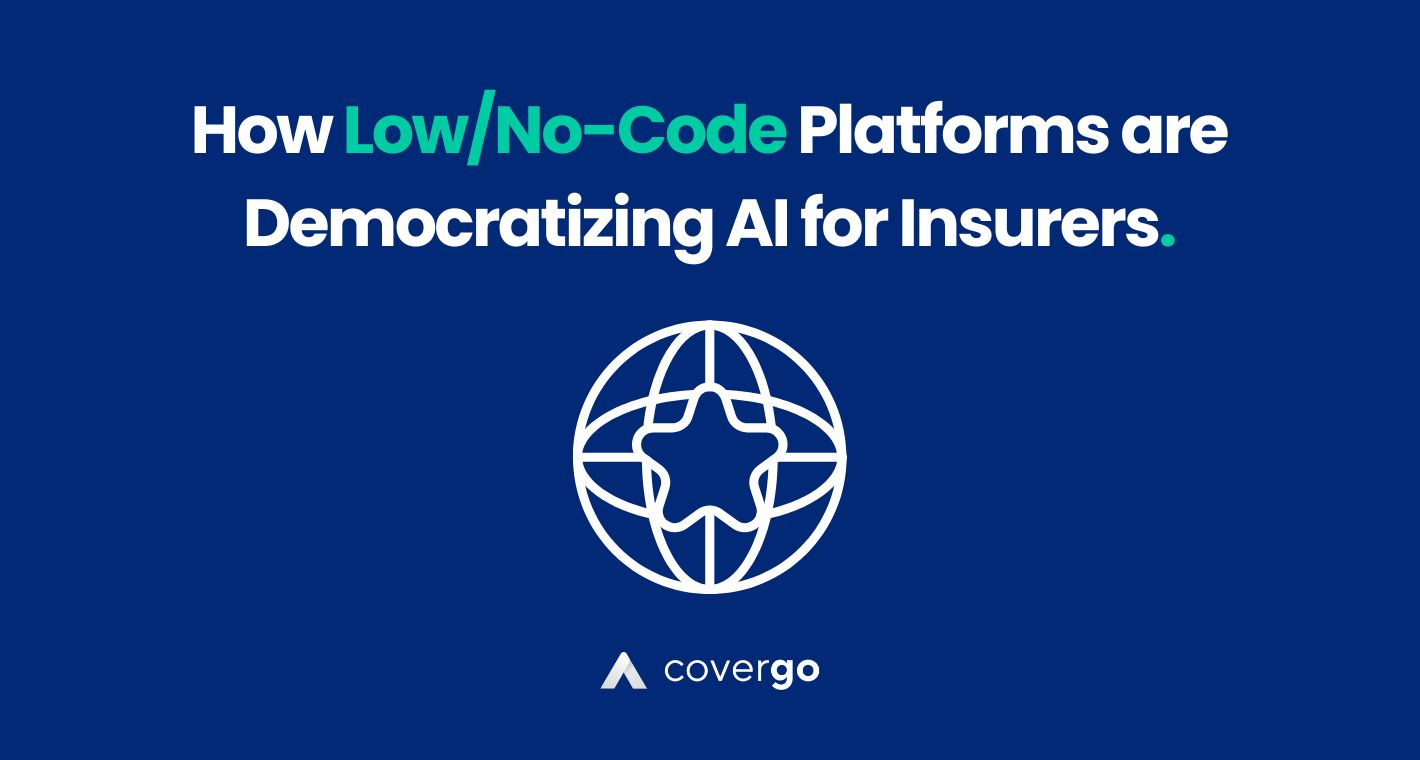Key Takeaways:
- NCLC platforms make AI accessible for non-technical individuals, allowing insurers to apply AI solutions without even needing any coding experience.
- By automating coding efforts, these systems save time and lessen the likelihood of encountering flaws, as templates have previously been tested. This makes the lives of insurers so much easier and allows them to improve their work efficiency.
- Reducing the need for specialist AI developers decreases operating expenses and makes AI deployment more accessible.
What are Low-Code/No-Code (NCLC) Platforms?
NCLC platforms are platforms designed for individuals who lack coding knowledge and simply don’t have time to bother learning it but still want to get the same results. What makes these platforms interesting is the fact that they have been built on programming languages such as Python, PHP and Java. But do you know what’s even cooler about NCLC? Once you have the platform integrated, all you have to do is use the drag-and-drop components as after all, NCLC is a visual software development environment.
In the ever-changing world of insurance, staying on top of technological innovations is critical. Low-code/no-code (NCLC) platforms are transforming the way insurers use AI, making it available to everyone, regardless of technical experience. These platforms began their journey in the early 2000s, intending to simplify software development with visual tools that need minimum code.
A fundamental example is a spreadsheet, such as Excel, which enables complicated data operations via a visual interface. This democratization of technology has had a huge influence on enterprises worldwide. Just as spreadsheets revolutionized data processing, contemporary NCLC platforms are ready to alter the insurance sector by allowing people from all departments to design AI-driven solutions without requiring extensive programming experience.
For insurers, these platforms are game changers. They boost productivity by automating common tasks, lowering manual workloads, and limiting mistakes, resulting in speedier claim processing and better customer service. Furthermore, they provide cost-effective innovation, allowing insurers to create and implement AI solutions more economically while remaining competitive. AI models created on these platforms provide greater insights into customer behaviour, allowing for more tailored services and risk assessment. As NCLC systems advance, they can alter the insurance sector, integrating AI into operations and enabling insurers to innovate in a quickly changing environment.
Given that the insurance sector has already expanded out into many areas of business with its processes, there is an urgent need for something flexible that does not need a lot of development effort. While insurers want to go into the digital sector, they are also risk-averse and do not want to commit to something that would cost a significant amount of money and time.
Why insurers need NCLC platforms ASAP
In today’s day and age customers are also tired of having to wait ages for their insurance plans to be built and expect companies to adopt the latest solutions. AI enables insurers to meet these expectations by offering tailored policies, faster claims processing, and proactive customer service.
1. The first and most obvious reason why insurers must adopt NCLC platforms is that it will give them a competitive edge against their competitors who may only find out about this technology when it’s too late.
Insurers who adopt this technology will simply be more efficient as they can make tailor-made plans for clients much easier, there will be a lot more accuracy and it will be easier to make changes to plans through these platforms, ultimately leading to higher customer satisfaction.
2. Low-code/no-code platforms are transforming risk management and in the insurance sector by making powerful AI technologies available to all workers. In risk management, AI analyzes large information to detect patterns and anticipate hazards with more accuracy, hence improving underwriting and assessment procedures.
With NCLC platforms, insurers can quickly install these AI models, allowing non-technical employees to contribute to data-driven decision-making. This allows insurers to foresee possible challenges and tailor their products, resulting in better overall risk reduction.
3. In fraud detection, AI excels at detecting abnormalities and suspicious activity that legacy systems may miss. Insurers may create powerful fraud detection systems without substantial coding experience by incorporating AI into NCLC platforms.
This technique not only saves losses, but it also increases consumer trust by assuring more dependable and secure procedures. NCLC systems’ quick development and deployment capabilities enable insurers to remain nimble while better-tackling fraud and risk management concerns.
4. Low-code/no-code platforms improve operational efficiency in the insurance sector by automating common processes using AI. This automation enables insurers to shift their emphasis to more strategic activities like innovation and consumer engagement.
Insurers can dramatically cut operating expenses and increase overall efficiency by reducing the number of manual operations.
5. Maintaining compliance with changing regulations is a continual concern for insurers, and AI provides a solid solution. Insurers may use low-code/no-code platforms to create AI systems that assure accurate reporting and compliance with industry norms.
These platforms offer quick adaptability to regulatory changes without requiring considerable coding, lowering the risk of noncompliance.
AI can continually monitor compliance needs, delivering real-time insights and warnings to help insurers maintain high levels of accountability and transparency.
Because NCLC platforms are so easily accessible, these AI-driven solutions can be adopted rapidly by personnel with different technical abilities, ensuring that efficiency improvements are reached throughout the business.
Issues with NCLC platforms
Adopting no-code platforms in insurance organizations requires a significant cultural shift, similar to any new technology. Insurers must invest in learning and training to become familiar with these tools and break free from traditional silos. It’s crucial to recognize that there isn’t a one-size-fits-all solution.
Business leaders should be open to experimenting with various platforms to find the one that best suits their needs. Given the relatively recent emergence of commercial standard insurance software, numerous off-the-shelf options are available.
However, insurers often need help with integration issues and limited templates, which can hinder the addition of new features. To truly benefit from digital transformation, choosing a platform offering a competitive edge is essential.
This is where CoverGo stands out. Our innovative no-code insurance platform provides maximum flexibility, enabling insurers to streamline processes and create a variety of products with complete end-to-end integration. With CoverGo, you can build responsive front-end websites and client or agent portals without any coding. Designed for users with no technical background, our platform supports both simple and complex products. Reach out today to schedule a demo and see how we can help overcome these challenges.
Cost-Effectiveness and ROI
CoverGo’s deployment of NCLC platforms has resulted in significant cost savings for insurers by simplifying operations and minimizing the need for huge development teams.
With less coding required, insurers can dedicate resources to other essential areas, such as improving customer service or investing in other new technology. This is especially helpful has the database of insurers expands and they need a fast and efficient way to work.
These systems’ rapid deployment capabilities enable insurers to introduce new products and services to the market considerably more quickly. This not only increases competitiveness but also allows insurers to respond swiftly to market developments and client needs.
As a consequence, insurers can capitalize on new possibilities, adapt to developing trends, and retain a strong market presence.
Furthermore, the ability to deploy products quickly and effectively enables insurers to gain a strong return on investment. Insurers may focus on providing value to both consumers and shareholders by decreasing development time and expenses. This strategic edge enables businesses to succeed in a continuously changing industry landscape while assuring long-term development and sustainability.
Finally, the adoption of low-code/no-code (NCLC) platforms constitutes a significant shift in the insurance business. These platforms provide major competitive benefits to insurers by allowing them to streamline procedures, decrease costs, and increase innovation. They empower non-technical employees, speed up product development, and improve client experiences with tailored services.
Start today with CoverGo and enjoy efficiency, development, and power to face future problems with confidence.
FAQs
NCLC platforms are designed for individuals without coding knowledge, allowing them to develop software using visual tools like drag-and-drop components. These platforms enable users to create AI-driven solutions without extensive programming experience, making technology accessible to non-technical individuals.
NCLC platforms help insurers by automating coding efforts, reducing the need for specialist developers, and decreasing operating expenses. They enhance productivity, streamline processes, and allow for faster claim processing and improved customer service. Insurers can quickly deploy AI models to improve risk management and fraud detection.
Adopting NCLC platforms requires a cultural shift and investment in training. Insurers may encounter integration issues and limited templates, which can hinder the addition of new features. Business leaders need to experiment with different platforms to find the best fit for their needs.
By simplifying operations and reducing the need for large development teams, NCLC platforms lead to significant cost savings. They enable rapid deployment of new products, increasing competitiveness and allowing insurers to quickly adapt to market changes, resulting in a strong return on investment.
Recent posts
- How Low/No-Code Platforms are Democratizing AI for Insurers
- All of the ways AI is Transforming the Insurance M&A Industry.
- 10 Crucial Mistakes to Avoid When Filing an Insurance Claim
- 5 Important Tips That Will Make Filing Claims For Specialized Policies a Breeze
- Artificial Intelligence as The New Defender Against Insurance Fraud



